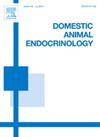Exploring the relationship between plasma and salivary levels of oxytocin, vasopressin, and cortisol in beagles: A preliminary study
IF 2.1
2区 农林科学
Q2 AGRICULTURE, DAIRY & ANIMAL SCIENCE
引用次数: 0
Abstract
Oxytocin, vasopressin, and cortisol are widely used as biomarkers to assess the temperament or emotional state of dogs. Typically, these levels are measured in blood; however, this invasive procedure can induce acute pain and stress. Considering the welfare of dogs, it is necessary to replace these procedures with noninvasive methods. Saliva sampling has emerged as a promising, noninvasive alternative for measuring hormonal levels. Nonetheless, it remains unclear whether saliva samples accurately reflect plasma hormonal levels in dogs. The objective of this study was to evaluate the correlations of oxytocin, vasopressin, and cortisol levels between plasma and saliva samples. We simultaneously collected blood and saliva samples from fifteen beagles, aged six, including eleven females and four sterilized males. Due to the limited availability of saliva samples, each analysis was performed on 5–11 dogs. Hormonal levels were quantified using commercial ELISA kits. Linear regression analysis and Pearson's correlation coefficient were used for statistical analysis. Our findings revealed no significant correlation between oxytocin or vasopressin levels in the plasma and salivary samples. However, a significant positive correlation was observed between cortisol levels in plasma and saliva samples. Additionally, oxytocin and vasopressin levels were positively correlated in both plasma and saliva samples. A positive correlation was found between the plasma cortisol and oxytocin levels, whereas no correlation was observed between the salivary cortisol and oxytocin levels. This study provides a foundation for understanding hormonal relationships across different matrices, contributing to the development of alternative sampling methods that prioritize animal welfare.
探索小猎犬血浆和唾液中催产素、血管加压素和皮质醇水平之间的关系:初步研究
催产素、抗利尿激素和皮质醇被广泛用作评估狗的气质或情绪状态的生物标志物。通常,这些水平是在血液中测量的;然而,这种侵入性手术会引起急性疼痛和压力。考虑到狗的福利,有必要用非侵入性方法取代这些程序。唾液取样已经成为一种很有前途的、无创的测量激素水平的替代方法。尽管如此,尚不清楚唾液样本是否能准确反映狗的血浆激素水平。本研究的目的是评估血浆和唾液样本中催产素、抗利尿激素和皮质醇水平的相关性。我们同时采集了15只6岁的小猎犬的血液和唾液样本,其中包括11只雌性和4只绝育的雄性。由于唾液样本的可用性有限,每次分析都对5-11只狗进行。使用商用ELISA试剂盒定量测定激素水平。采用线性回归分析和Pearson相关系数进行统计分析。我们的研究结果显示血浆和唾液样本中的催产素或抗利尿激素水平之间没有显著的相关性。然而,血浆和唾液样本中的皮质醇水平之间存在显著的正相关。此外,血浆和唾液样本中的催产素和抗利尿激素水平呈正相关。血浆皮质醇和催产素水平呈正相关,而唾液皮质醇和催产素水平无相关性。本研究为理解不同基质之间的激素关系提供了基础,有助于开发优先考虑动物福利的替代采样方法。
本文章由计算机程序翻译,如有差异,请以英文原文为准。
求助全文
约1分钟内获得全文
求助全文
来源期刊

Domestic animal endocrinology
农林科学-奶制品与动物科学
CiteScore
5.50
自引率
4.80%
发文量
58
审稿时长
31 days
期刊介绍:
Domestic Animal Endocrinology publishes scientific papers dealing with the study of the endocrine physiology of domestic animal species. Those manuscripts utilizing other species as models for clinical or production problems associated with domestic animals are also welcome.
Topics covered include:
Classical and reproductive endocrinology-
Clinical and applied endocrinology-
Regulation of hormone secretion-
Hormone action-
Molecular biology-
Cytokines-
Growth factors
 求助内容:
求助内容: 应助结果提醒方式:
应助结果提醒方式:


